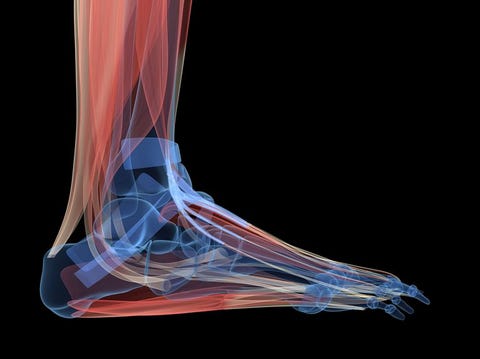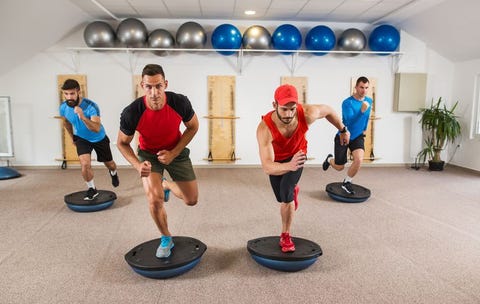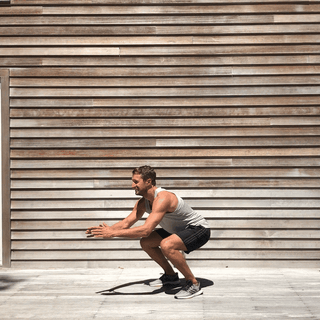Before you get ready for a big lower body workout, make sure you can be steady on your feet underneath you. Weak and wobbly ankles are an easy precursor to many different types of injuries.
To avoid many different types of injuries that occur while on your feet, try throwing some proprioception training in with your strengthening routine.
What is Proprioception?
You can strengthen the muscles in and around your ankles all you want, but if you lack good proprioception, your ankle strength isn’t going to help you. Proprioception is perception or awareness of your body’s position and movement in space. Basically, it’s your brain’s ability to orient yourself in space.
There is a feedback loop between your peripheral nervous system (particularly sensory receptors) and your brain that helps your brain send the quick signals it needs to help you stabilize long before you have had time to make a conscious decision about which muscles to activate. So, for better ankle stability, you’ll want to bolster both systems—the neuromuscular and the musculoskeletal systems.
The Muscles of the Ankle

There are many muscles that cross the ankle joint, including the gastrocnemius, soleus, posterior tibialis, flexor hallucis longus, and peroneal longis and brevis. You’ll want to strengthen these muscles in a few different ways. Each muscle contributes to both moving your ankle and stabilizing the ankle joint.
When muscles on one side of the joint contract or shorten, the ankle moves in that direction, simultaneously lengthening the muscles on the opposite side. When you want to stay still, instead of none of the muscles being active, you want multiple muscles to work together, or “co-contract” preventing movement in multiple directions at the same time.
Many of the strengthening exercises for the ankle focus on ankle stability, which is important for any running or jumping sport, as well as daily function. But ankle stability doesn’t just come from your muscles—it also comes from your brain. This is where proprioception matters By practicing these drills, you can help your brain know how and when to stabilize the ankle joint, and support that system with stronger ankle muscles.
Check out this list of ankle exercises that target both the muscles in and around the joint, as well as the system that helps activate them when you need them most.
Ankle Strengthening Exercises
Standing Heel Raises
Two up, two down
Stand at a kitchen counter or table so that you can lightly touch the surface for stability. Begin standing normally, with feel hip width apart. Slowly lift up your heels by going up on your toes. Slowly lower yourself back down with control (don’t just drop).
Be sure to stay in control of the movement and go all the way onto your toes as long as this movement is pain free. Try not to let your ankles roll as you do this. Repeat for 2 to 3 sets of 10. Stretch your calves afterwards.
Standing Heel Raises
Two up, one down
This variation of heel raises is slightly more challenging. Begin the same way, going up onto your toes. Then, instead of lowering down both heels at the same time, remove one foot so that you are standing on the toes of one foot and lower down only with that one foot.
Repeat by going up with both feet, then down with one again. Do this 10 times on one side, then 10 times on the other side.
Single-Leg Balance on an Unstable Surface

Getty Imagesskynesher
One of the best ways to improve ankle stability is to challenge the ankle’s stability. Try using an Airex or any other type of dense foam or slightly squishy surface. Simply stand on one foot and try to balance for at least 30 seconds. If your ankle is wobbling all over the place or if you cannot maintain your balance for more than 5 seconds, you might not be ready for this exercise.
If 30 seconds on one foot is easy, try a softer surface or using the round side of a BOSU ball and add throwing a ball up and down in place if you’re alone, or playing catch with a friend if someone else is around. Still easy? Use a weighted ball and have your friend throw it to each side of you so that you throw off your center of gravity.
Resisted Ankle Eversion and Inversion
This exercise requires a resistance band. Tie a small loop at the end of a 3-foot elastic resistance band. Loop your foot into the hole. Begin by placing the center of the loop around the base of the big toe. Wrap the band so that you create a line of pull perpendicular to your leg from that point.
Begin with the foot rotated toward the little toe. Then, slowly move your foot out towards the big toe against the resistance without moving your knee. Gently return foot to starting position with control —do not let the band whip it back. Repeat with the band set up the opposite way—with the loop around the base of the little toe and the band anchored to the opposite side. Perform 10 to 15 reps of each.
Star Exercise
Stand in one place and set up cones in a “star” formation, with 5 cones in a circle around you. While balancing on one foot, tap each cone gently as you make your way around the “star.”
Note: one cone will require you to reach diagonally behind you and another will require you to reach diagonally in front of the leg your balancing on. Repeat the cycle 5 times. If it’s easy, try it standing on a squishy or unstable surface like an Airex foam pad or a BOSU.
Squat Jumps

Men’s Health
The gastrocnemius and soleus muscles are key muscles for propulsion and power. They act like a wound-up spring storing kinetic energy that, when release, creates an elastic energy to propel you into the air.
Squat jumps are a great exercise to strengthen these muscles while also strengthening the glutes, quads and hamstrings. To perform, begin in a standing position with feet hip width apart. Slowly lower down to the ground before jumping straight up. Continue to jump straight up pushing off of your toes while squatting between each jump.
Squats on Balance Board
Whether you’re riding public transit or just standing on an uneven surface, try adding a dynamic component to your balance drill to increase the challenge.
To perform, stand on a balance board or wobble board with one fulcrum of movement (medial to lateral or anterior to posterior). Bend your knees slightly to try and find stability, then perform 10 squats without letting either edge of the board touch the ground.
Soleus Presses
The soleus is a broad, flat muscle under the perky gastrocnemius that is key in walking, running, balancing and jumping. To strengthen the soleus, try soleus presses. Sit with your knees bent, toes on a Smith machine bar and weight over your knees. With your toes in contact with the floor, slowly lift your heels pressing up onto your toes. Then slowly lower back down. Control is key. Perform these until fatigue.
Source: Read Full Article
